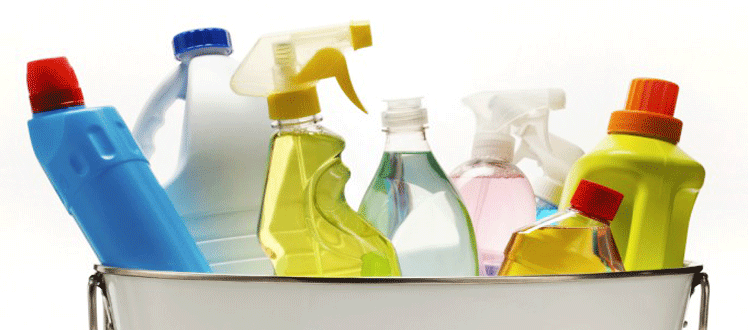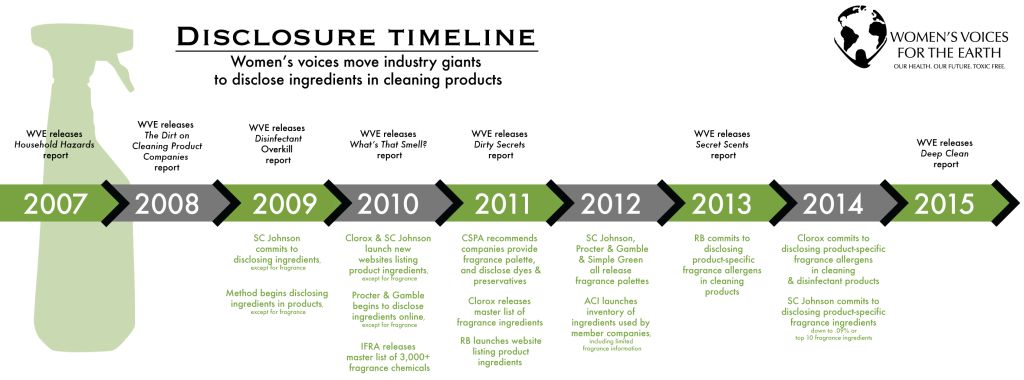Ingredient Disclosure: Moving the Market to Safer Products
 |
| Jamie McConnell Director of Programs & Policy |
Leading the Way for Ingredient Disclosure Because It’s Our Right to Know!
As we celebrate Women’s Voices for the Earth’s 20th anniversary and look back at two decades of accomplishments, one of the areas of our work that stands out is the advances we have made in ingredient disclosure. Women’s Voices started this work with the publication of Household Hazards, the first report to expose the presence of toxic chemicals in retail cleaning products. In 2007, when the report was released, virtually no cleaning product companies were disclosing any ingredients on a website or label — even if the ingredients were linked to cancer or reproductive harm like infertility and birth defects. The outcry in response to the report was immediate. Thousands of people began contacting companies to request disclosure of the ingredients in their products.
Fast forward eight years and cleaning product giants Clorox, Procter and Gamble, SC Johnson & Son and Reckitt Benckiser (RB) are voluntarily disclosing nearly all ingredients (primarily online) and even some ingredients in fragrance, as a result of consumer demand. Women’s Voices targeted these companies because they market the most well-known cleaning products on store shelves, including Lysol, Windex, Glade, Air Wick, and Tide.
A Timeline of Ingredient Disclosure:
(click image to enlarge)
Moving the Market to Safer Products
The advances we’ve been able to make in ingredient disclosure are significant and we couldn’t have done it without the thousands of women who raised their voice for the right to know. Knowledge is power and knowing what ingredients are being used in products like cleaners gives women the ability to avoid potentially harmful ingredients, and gives researchers and non-profits the information we need to study chemicals more in-depth. This information will help push the market toward safer products as more and more women choose products that don’t contain harmful chemicals. Without ingredient disclosure there is very little incentive for companies to make safer products. That’s why when WVE started this campaign we told women to make their own green cleaners until companies came clean on what they were using. While there have been advances in fragrance disclosure, with companies like RB and Clorox disclosing fragrance allergens in products, and SC Johnson disclosing even more fragrance chemicals, we think they can do better. Besides allergens there are unfortunately still dozens of chemicals used in fragrance that are toxic and women have a right to this information.
Women’s Voices believes we have a fundamental right to know what is in our products and we won’t stop until companies disclose every last ingredient, including ingredients in fragrance. Join Women’s Voices for the Earth’s action network and help us fight for our right to know!
You can also show your support for the Cleaning Product Right to Know Act. This act requires full disclosure and product labeling of household and institutional cleaning products – including fragrance chemicals!
A Timeline of Ingredient Disclosure:
2007: WVE releases Household Hazards, the first report to expose undisclosed toxic chemicals in retail cleaning products.
2009: SC Johnson & Son announce they will disclose ingredients, including dyes and preservatives but not fragrance.
2009: Method begins disclosing ingredients in products, except for fragrance.
2010: Clorox launches a new website listing product ingredients, except for fragrance.
2010: Procter and Gamble begins to disclose ingredients online, except for fragrance.
2010: International Fragrance Association (IFRA) releases master list of 3,000 + fragrance chemicals
January 2010: Consumer Product Specialty Association (CSPA) releases a voluntary Ingredient Communication initiative
2011: Consumer Product Specialty Association enhances the Ingredient Communication Initiative and recommends companies link to IFRA’s master list of fragrance ingredients or create their own fragrance palette, and disclose dyes and preservatives.
2011: Clorox releases a master list of fragrance ingredients.
2012: SC Johnson releases fragrance palette.
2012: Procter and Gamble releases fragrance palette.
2012: Simple Green releases fragrance palette.
2012: The American Cleaning Institute, a trade association that represents cleaning product companies, launched an inventory of ingredients used by their member companies. The list includes only limited information on fragrance ingredients, as most companies are not disclosing the chemicals they use in fragrances
2013: Reckitt Benckiser (RB) announce they will disclose product-specific fragrance allergens in cleaning products, starting with the air care line Air Wick. 2013: WVE launches No Secrets Business Partners project with several cleaning product manufacturers committed to full ingredient disclosure, including all fragrance ingredients.
2014: Clorox announces they will begin to disclose product-specific fragrance allergens in cleaning and disinfectant products.
2014: SC Johnson & Son release a statement announcing they will disclose product-specific fragrance ingredients down to .09% or the top ten ingredients in fragrance.




